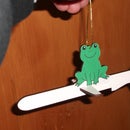Introduction: Smarter Than a Bag of Hammers
In the workshop, there is a need to hit different things. So one needs different hitty things.
These were not stored in a bag, because that would have been dumb.
These were all stored in a box, jumbled up anyhow, which meant that grabbing the correct hammer required both a hand and an eye.
Building an insert for the toolbox so that each hammer would always be in its allocated place would be neater and make it faster to find the correct tool.
Step 1: First Layout
The first thing to do was to check that everything would fit neatly.
They did! (Sort of). Having the cobblers last in the box made sense functionally, but it is awkward shape and takes up a lot of room. After a bit of thought and a few reshuffles, I decided that having it sit atop the less-frequently used hammers would allow easy access to the more common tools, while imposing an acceptable inconvenience.
Step 2: Cut and Check
To fit the head of the tool into the tray and hold it, I decided to have a layer of hardboard and seat it in the base of the toolbox.
Since everything depended on the positioning of the cobbler's last, it was marked and cut out first, then the hammers had their heads marked around in two batches.
After the first few holes were cut, a test-fit was done, and then the second lot were cut out.
To cut out the odd-shaped holes, a variety of methods were used. Some smaller round holes were drilled out with a Forstner bit. U-shaped cut-outs at the edge were done by cutting in from the side with a jigsaw and larger holes in the middle of the board were done by drilling a 10mm (three-eighth) pilot hole with a bit and then using the jigsaw.
Step 3: Increase the Standoff
Scraps of 12mm (half inch) ply were glued to the underside of the board to provide some torsional stability and to increase the standoff from the bottom of the toolbox.
The increase in depth of the base beneath the cut-outs would hold the larger hammers more securely, and allow the smaller tools whose heads were located above the edge strips on the base of the toolbox to have some support.
Finally, some scraps of wood were put in the middle of the board to support the centre against the base of the toolbox.
End result, much easier to grab the right hammer quickly.





